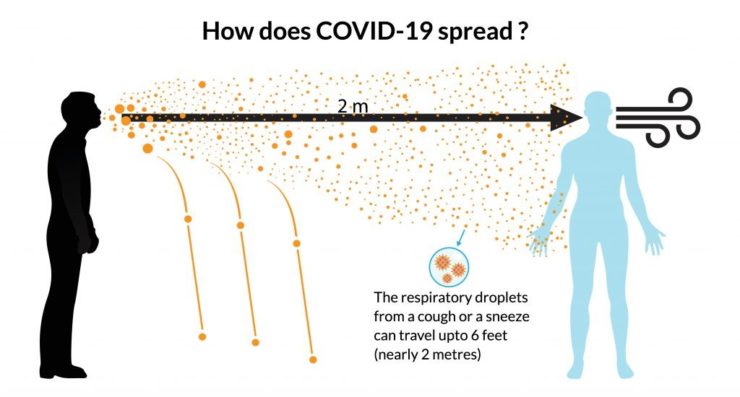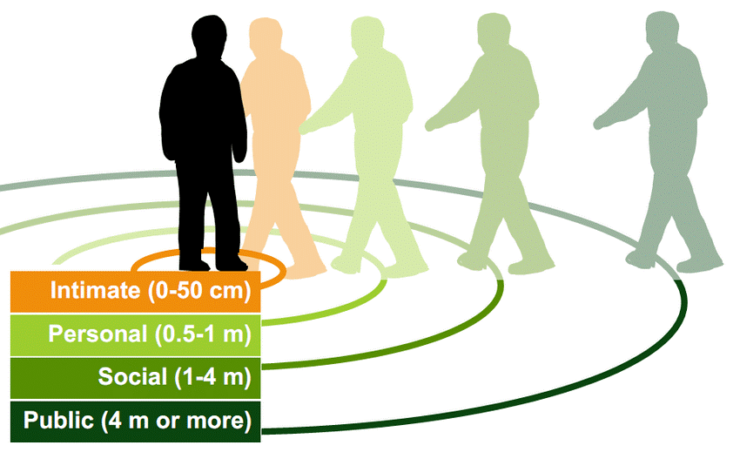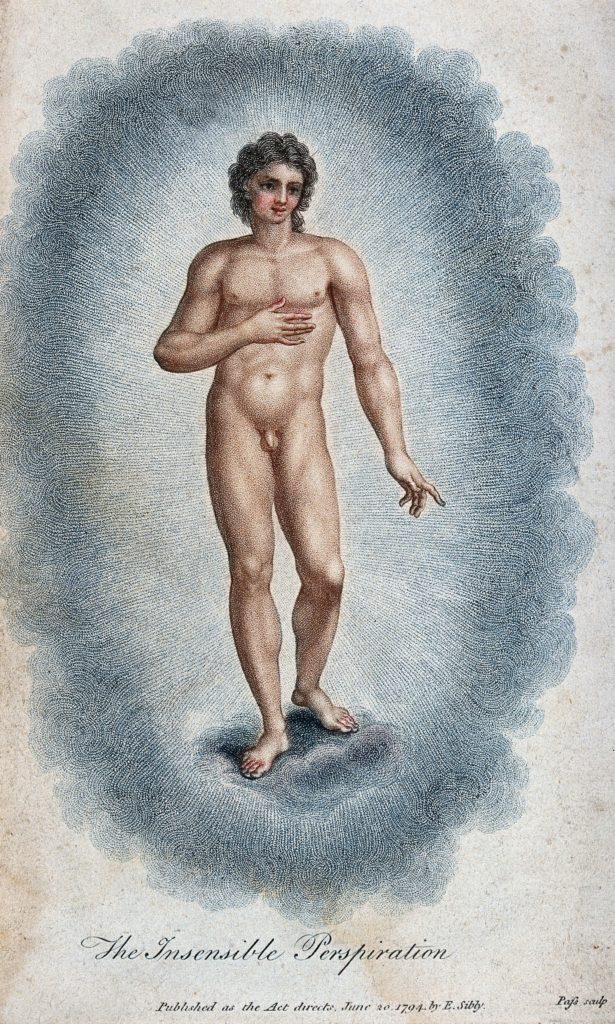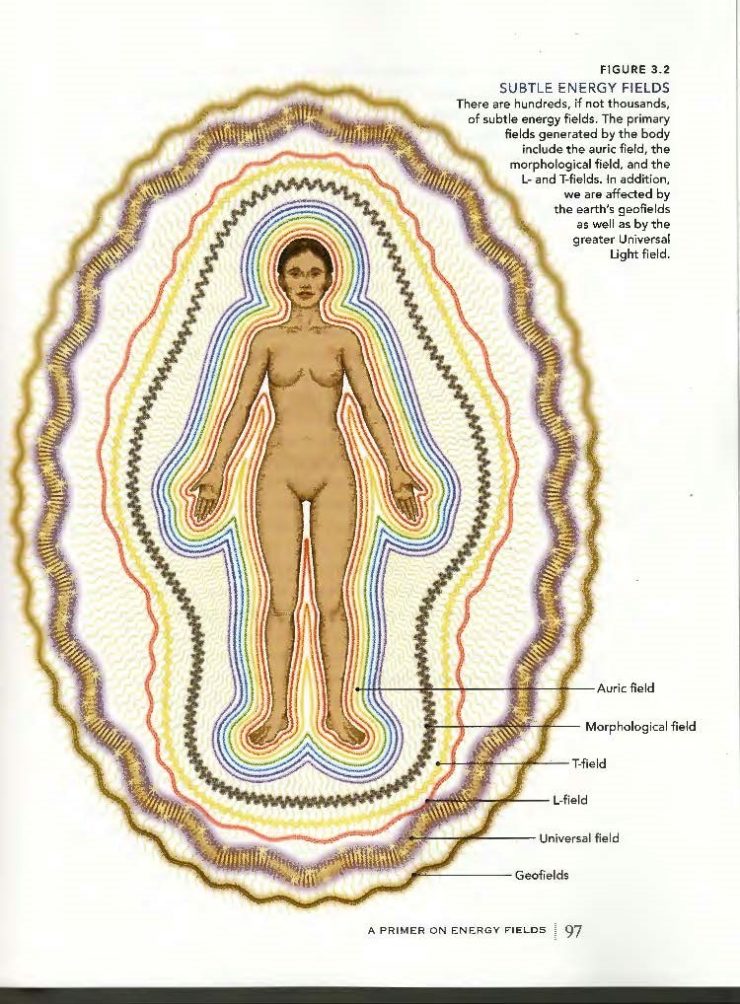Jeremy Stolow
In recent years, it has become commonplace in academic scholarship as well as popular culture to treat the human body as a complex assembly of forces and interactions. Arguably, this vision of the body belongs to a larger sensibility that has enjoyed a remarkable ascension in recent years (at least so far as putatively secular Western societies are concerned), whereby the entire cosmos is understood to be infinitely plural, restlessly transforming, endlessly enfolding and unfolding. Whether in the case of the billions of bacteria that inhabit our digestive tracts or the latest technologies that enable us to establish our presence in the far reaches of cyberspace, we have all come to appreciate the multiple ways our embodied existence neither begins nor ends at the surface of our skins. Processes of inhalation and exhalation, or of ingestion, digestion and excretion, point to only some of the most obvious instances where the boundaries supposedly dividing bodily interiors, surfaces, and outer environments are in fact porous and labile. And so, what might from a very distant perspective look like a single, unitary entity invariably turns out, on closer inspection, to comprise a multitude of cohabitations and networked interactions. The universe, and biological life in particular, we are given to understand, exists in a constant state of absorption and eruption. Every solid thing is nothing but a swarm of hidden forces. Every living thing radiates. All surfaces seep, leak, or bleed.
The current global pandemic wrought by the spread of the SARS-CoV-2 virus has not simply corroborated this wisdom; it has reworked our understanding of the porous, plural (and vulnerable) body in remarkable ways. Everyday activities such as navigating a city street or the aisles of a supermarket have required us to redraw the boundaries dividing intimate from public space. Add two metres to your body in movement and you create not only a new habitat but also a new body. At a broader, macrosocial scale, we can note how a whole new raft of terminology, precepts, and specialized apparatus have entered our everyday lexicon when it comes to the management and care of both individual and collective bodies: physical distancing, the 2- (or 1.5-) metre rule, transmission vectors, aerosolized pathogens, genetic mutations, ventilators, face masks. The rarefied language of microbiology and epidemiology now pervades daily news reports, economic forecasting, public policy decisions, humour, artwork, and not least, religious discourse and practice. Once settled relations of knowledge, habit, technique, and ethical orientation that govern the care and coordination of bodies are being dramatically re-conjugated in the wake of this virus’s sudden arrival. While hardly unique or unprecedented, the current pandemic has indeed produced a strange, disorienting, and terrifying situation for embodied human life, exercised on a global scale. As such, it demands critical reflection, even at the risk that current analyses might be composed too hastily, before we can even see where this drama will ultimately lead us.
As already evident from some of the other contributions to this dossier, critical reflection on the meaning and consequences of the coronavirus pandemic requires, in the first instance, some careful thought with regard to the status of scientific knowledge and the position of scientific professionals in this rapidly evolving landscape. What, if anything, can this pandemic teach us about the way scientific knowledge is formed, communicated, and acted upon, and how, in turn, might such observations challenge existing assumptions about the very distinctions between science and non-science, nature and culture? This is not simply a question about the relationship between the authoritative, ‘data-driven’ knowledge produced by biomedical professionals and the vulgar interpretation and practical applications of that knowledge once it reaches the hands of non-experts. Notwithstanding the efforts of conspiracy theorists (who lay the blame of the virus’s origins and spread on secret ‘deep state’ laboratories or 5G cellphone towers) or politicians drunk in the illusion of their own expertise (epitomized by US President Trump’s wild speculations about the virus’s aetiology and potential remedies), we are witnessing on a truly massive scale an urgent cry of thirst for carefully weighed, credible scientific pronouncements on every conceivable aspect of this pandemic. As Pamela Klassen and Janelle Taylor explore in their contribution to this dossier, in many quarters the dramatically escalating threats carried by the virus have elevated biomedical professionals to a new rank of white-coated saints, marching in lock-step with a vast army of doctors, nurses, and other essential workers who, like modern-day bodhisattvas, heroically lay their lives on the line for us every day. In the larger mediasphere of late modernity, such performances of ‘faith in science’ might seem counterintuitive, since they do not conform with the premise that populist movements are inherently hostile to professional scientific knowledge as an ‘elite privilege’. And it remains the case, tragically if unsurprisingly, that efforts to contain the spread of the virus are being challenged by protesters in many countries who flout the authority of medical experts and question the legitimacy of government-imposed lockdowns and physical distancing rules. Nevertheless, even in these expressions of resentment and protest against biomedical expertise, what is being played out on the ground cannot be adequately explained in terms of fixed positions of ‘pro-’ and ‘anti-’ science. Responses to the pandemic do not simply demonstrate the fact that science is always entangled with other things, such as culture, politics, religion, or ‘the popular’ (after all, there has never been such ‘pure’ scientific knowledge). Rather, they reveal how the pandemic weaves together science and non-science in novel ways, producing a situation that cannot be contained within the tidy binarisms of fact vs. value, ontology vs. ethics, or pure vs. practical reason.
For these reasons, I suggest that the Corona virus can fruitfully be defined as a sort of boundary object, in the sense defined by Geoffrey Bowker and Susan Leigh Star: “objects that both inhabit several communities of practice and satisfy the informational requirements of each of them.” And as a boundary object, it provides an opportunity to rethink the relationship between so-called scientific modes of knowledge and practice and other ways of knowing and doing, including ones we typically locate under the category of ‘religion’. In her contribution to this dossier, Birgit Meyer likewise proposes that “religious and medical thinking may share a deep common ground. Such a common ground, which is still to be charted, could serve as a productive starting point for our attempts to reconfigure our understanding of the social.” As a contribution to this call for further exploration, I offer here a few comments on the figure of the body that we see everywhere coming into focus alongside the pandemic’s spread, which for the purposes of this discussion might be called the ‘pandemic body’ (Fig. 1).

The pandemic body is a rather expansive creature. It comprises a complex cohabitation of parasites and host within a structure we call the ‘human body’, but it also includes the uniquely individual microenvironment within which that body is situated: an enveloping airspace populated with aerosolized droplets of saliva and perspiration, dead skin cells, fungi, bacteria, viruses, chemical particles, and other microscopic entities that scientists now refer to as our ‘microbiome’ or ‘exposome’. Wherever one may wish to draw the line delimiting a territory called ‘the human individual’, it seems that we cannot extricate that body from its surrounding haze of microscopic activity (Fig. 2). The current pandemic has both sharpened and recalibrated our sense of this indefinite territory linking body and environment. Today, we are all quite literally living within the contours of pandemic bodies, and we are learning how to operate them under the virus’s cruel tutelage. Our everyday perceptions of where one bodily presence ends and where another begins are now dominated by a calculus of risk and threat (but the exigencies of cohabitation make all such assessments ambiguous at best, a point well underscored by the lack of consensus regarding what counts as appropriately safe physical distancing among political regimes that have enacted regulations ranging from one to two or more metres). Our sense of this pandemic body is also reflected in the multiplication and widespread circulation of its visual representations, especially in the form of infographics that aim to illustrate the thresholds of risk and threat posed by one distant body upon another (as presented in Fig. 1, and the countless public health announcements that resemble this image).

But the SARS-Cov-2 virus is not the original progenitor of this pandemic body. For one thing, this is not the first pandemic to have imposed disciplining effects on cohabitating bodies, inculcating large populations in the habitual use of facemasks or physical distancing rules. A more thorough archaeology of the figure of the pandemic body would attend to those recent historical precedents, but would also need to consider comparable accounts of bodily territorialization, such as can be found in the history of academic discourse on human sociability. In this regard, one tempting case to consider is that of proxemics, the applied science first elaborated by the anthropologist Edward T. Hall in his pioneering (and delightfully titled) book, The Hidden Dimension. Although defined, perceived, and experienced in culturally variable ways, Hall argued that all humans distinguish intimate, personal, social, and public relations with others in spatial terms, which can be depicted as a series of expanding circles that designate ‘appropriate distance’, the crossing of which can be perceived by any given individual as invasive (Fig. 3). But for Hall, this enlarged sense of self is a product of our ingrained psychological perceptions, our motor responses, and our cultural conditioning. Sensing and negotiating with another person’s bodily presence is largely a matter of one’s ability to perceive and measure distance, and the culturally inscribed codes that give meaning to those perceptions. The pandemic body, by contrast, cannot be reduced to differences in perception or normative codes of conduct. It is not simply a matter of re-drawing the concentric lines separating intimate and personal space from social and public space, since the dance of host and parasite is not exclusively a cultural or psychological construct. Culture and nature, human and nonhuman, body and environment are all conjugated differently within the contours of the pandemic body.

No less should we be satisfied with the claim that the pandemic body is merely a ‘discovery’ of scientific investigation, a naturally occurring pattern of interspecies behaviour and environmental conditions that are simply being observed and documented through ongoing research. While it is certainly the case that microbiologists, virologists, epidemiologists, and others have generated a vast archive of new (and urgently needed!) knowledge about the contours and operations of what I am here calling the pandemic body, it is nevertheless striking that this visualization precedes and extends far beyond anything we can call ‘properly scientific’.
For one thing, I would point out, depictions of physical distancing and of the pandemic body that we find proliferating today draw upon a visual iconography that can be traced through long histories of artistic representation of the human body as shrouded in clouds, radiant lights, or rings of fire, such as can be found in innumerable depictions of deities, saints, emperors adorned with a halo or radiant crown, or enveloped in an aureole or nimbus. Likewise, in the history of medical illustration, long before the advent of the microscope and the discovery of microbial life, one can find many depictions of the living body immersed in a cosmic ocean of hidden pathways connecting the inside and the outside. Such visions of the body are in fact strikingly commonplace in pre-modern European anatomical atlases (where bodies are placed in a bath of vapours and humours, effluvia, and imponderable fluids) as well as non-European repositories of medical and spiritual knowledge, such as in Traditional Chinese Medicine or Ayurveda, where acupuncture charts, chakra diagrams, and related illustrations depict the living being as an assembly of subtle yet vital energies that circulate both within and beyond its gross physical mass. Another iteration of this body figure can be found in the visual culture of that remarkable medical-social-esoteric movement known as Mesmerism, which predominated from the end of the eighteenth century and which continues to provide intellectual support for a range of practices sometimes gathered under the term, ‘alternative medicine’ (Fig. 4).

It is important to add that this sort of visualization of the radiant body is far from obsolete. In fact, it continues to proliferate in contemporary arenas of practice that intersect but also directly compete with orthodox biomedical visualizations of the body, such as in the context of the so-called New Age marketplace of spiritual goods and services: an arena dedicated to the conceptualization, management, care, and healing of human bodies that for their part are understood to be inextricably located in a web of ethereal vibrations, imponderable fluids, aura energies, and celestial forces of attraction and repulsion that are said to govern our cosmos (Fig. 5).

The term ‘New Age’ is often used somewhat pejoratively to refer to a predominately middle-class, Western, consumerist, and hyper-individualistic form of pseudo-religion and pseudo-science: a pastiche of naïve Orientalist tropes, superficial appeals to scientific theories of energy, matter and life, dubious medical practices, and kitschy aesthetics. This is not the place to demonstrate the various ways this characterization fails to capture what is actually taking root in the multiple fields of activity where so-called New Age ideas, practices, and agents can be found. But the ease with which many commentators dismiss New Age depictions of the body as merely pseudo-scientific should register some suspicion on our part – not least, among scholars of material religion. What indeed are we to make of this striking confluence between the image of the aura body ubiquitously found in New Age visual culture and the figure of the pandemic body? Is one real and the other merely imaginary: a ‘cultural construction’ that crudely imitates what science ‘truly’ reveals?
Answers to these questions must be parsed carefully. For one thing, it is far from evident that the observational techniques sanctioned by modern orthodox biomedicine fare dramatically better when it comes to the question of observing our ‘real’ bodily selves. As argued by a chorus of medical historians and anthropologists, the penetration of the human body by diverse visual instruments – such as radiography, endoscopy, and magnetic resonance imaging – does not proceed in a linear fashion toward an ever-more complete picture. Instead, different imaging technologies produce diverging, even contradictory visualizations that can collide and even compete with one another. In all these cases, instruments and technical procedures sanctioned for observing and visualizing the body are governed by somewhat shaky assumptions about ‘what is there’, what a given technology can sense, what counts as a successful image, or how to interpret the referential power of such images with regard to hidden or elusive dimensions of reality, whether we name them ‘consciousness’, ‘pain’, ‘vitality’, or ‘spiritual force’. Perhaps, one might go so far as to suggest, all visual knowledge about living bodies is in some way indeterminate, if for no other reason than because of a fundamental phenomenological condition of all pictures: that every disclosure is always only a partial disclosure, that every act of showing something implies that other things must be hidden from view.
More broadly stated, modern Western biomedical knowledge of human anatomy and physiology – formed through the history of cadaveric dissection, microscopial observation, and pharmacological intervention – does not represent the victorious arrival of a ‘true’ picture of the body, but rather only one among several historically contingent knowledge systems, each rooted in its particular cultural, institutional, and technological conditions of production. Indeed, modern Western bio-medical sciences have yet to arrive at a definitive, final picture of the dynamism of living bodies, and perhaps they never shall, just as ‘health’ and the removal of bodily ailments remain frustratingly elusive goals: a point that the current Covid-19 pandemic has made abundantly clear, not only as a problem of medical knowledge per se but also in its enactment as coherent public health policy. In sum, it is hardly obvious that orthodox bio-medical knowledge of the body provides a stable counterpoint to the various ‘non-scientific’ – that is to say, ‘cultural’, or for that matter, ‘religious’ – representations of the body with which it apparently competes. As hopefully already evident from the scattered examples introduced above, visualizations of the pandemic body emerge in the context of a much larger and older iconography of radiant bodies and this visual storehouse shapes the ways scientists conceptualize their objects of study just as much as the way they communicate with outsiders.
In saying this, my aim is not to suggest that normative biomedical constructions are entirely unreliable or arbitrary, nor do I wish to imply that the multiple sources of visual knowledge produced and interpreted by medical professionals cannot be concatenated into a single, coherent totality called ‘the body’. Nevertheless, so-called ‘alternative’ techniques for generating body knowledge – although frequently maligned as ‘not scientific’ when compared to knowledge produced under the auspices of the modern Western biomedical gaze – are no less (but also no more!) metaphorical. So, for example, as argued by Projit Mukharji in his remarkable book, Doctoring Traditions, it is not the case that practitioners of non-Western biomedicine, such as Ayurveda or Traditional Chinese Medicine, somehow fail to notice or understand the anatomical or physiological features of the body revealed by Western science. Rather, they begin with different ‘root metaphors’ to answer fundamental questions about the composition of bodies and the conditions under which different bodily states can be observed. Moreover, the availability of different metaphors does not imply that the medical systems they engender are mutually exclusive. In his account of the history of interactions between Ayurvedic and Western medical observational and therapeutic techniques, Mukharji illustrates this very point by demonstrating in detail how, throughout the history of Ayurveda, competing understandings and visualizations of the body, derived from Western biomedicine as well as from Indian traditions, have been ‘braided together’ both epistemologically and pragmatically.
New Age knowledge of the body is likewise formed as a sort of braid, woven together from a wide variety of distinct religious, scientific, artistic, esoteric, and cultural strands of discourse and practice. While some might see this braiding as a corruption or contamination of ‘proper science’ (or indeed, ‘proper religion’), it is also possible to take it as the creative, generative ground upon which new possibilities of imagining and enacting both science and religion emerge. For one thing, it might turn out that the figure of the body and its surrounding aura – so prevalent within New Age-inflected cosmology, therapy, and artwork – does more than simply (mis)translate scientific vocabularies and visual knowledge into a popular (nonscientific) register. If, in the current, globally-resonant flurry of efforts to define and manage the pandemic body, it seems increasingly untenable to hold onto the ‘modern Western’ view of human life as an enclosed system of organs and tissues, fluids and pumps, batteries and wires, it behooves us to pause, if only briefly, to consider the remarkable ways that New Age discourse and visual culture have already been at work enlarging the radius of embodied human life and identifying its multiple vectors of self- expression as well as danger and threat (Fig. 6).

Acknowledgements
My thanks to Birgit Meyer for her encouragement and incisive comments leading to the revision of this work. I am also grateful to Jojada Verrips for having introduced me to proxemics.
Bio-Note
Jeremy Stolow is Associate Professor of Communication Studies at Concordia University, Montréal, Canada. He teaches and conducts research on religion and media, with a particular interest in the overlapping worlds of religion and technoscience. His current book project, Picturing Aura, deals with the history of efforts to photograph the human aura, an enterprise that crosses the worlds of science, religion, art, entertainment, esotericism, and alternative healthcare.
This blog is a part of ‘Dossier Corona’, introduced by Religious Matters in the spring of 2020.
